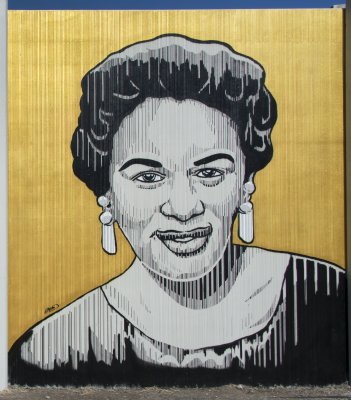Dr. Lydia T. Wright

Edreys Wajed’s portrait of Dr. Lydia T. Wright for The Freedom Wall, 2017. Photograph by Tom Loonan.
Dr. Lydia T. Wright dedicated her life to her community both as a doctor and member of the Buffalo Board of Education. After graduating from Meharry Medical College in Nashville, Tennessee, and completing her residency at Harlem Hospital in New York, Wright and her husband, Dr. Frank G. Evans, moved to Buffalo and opened their own practice on Jefferson Avenue in 1952. Wright became the city’s first African American pediatrician, serving generations of children in the community over what would be a thirty-six year career as a physician.
In 1962, Wright was elected to the Board of Education, vowing to be “the community’s voice during Board debates on school racial integration.” At the time, Buffalo public schools were among the most dramatically segregated in the country and their integration over the course of the 1960s was highly contentious. In 1963, Wright was the only Board member to vote against a plan to district the new Woodlawn Junior High School so that it would be exclusively African American; two years later and following a petition by the local branch of the NAACP, the school was forcibly desegregated by the New York State Education Department. During her five years on the Board, Wright fought to develop busing and redistricting plans that would more evenly distribute African American and white students across schools in the district. As a draw for students and their families, she proposed that each high school have a specialization—an idea that anticipated the city’s current magnet school system. In 2000, the Buffalo Common Council agreed to name a new school the Dr. Lydia T. Wright School of Excellence in honor of “her struggle to integrate our school system and to get people to know one another and appreciate one another for who they are, regardless of color or creed.”
